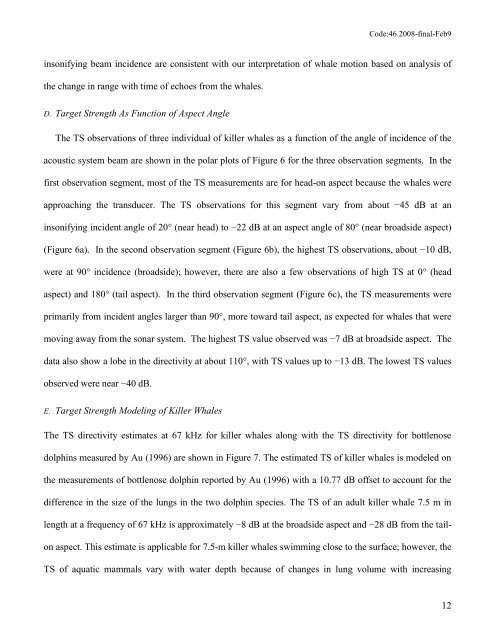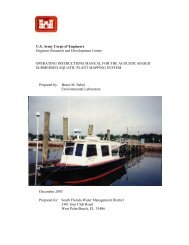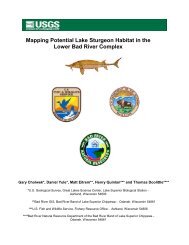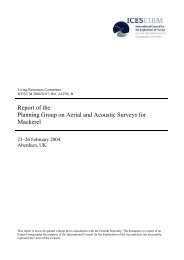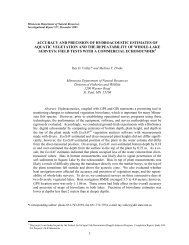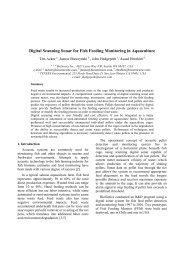Target Strength of Southern Resident Killer Whales ... - BioSonics, Inc
Target Strength of Southern Resident Killer Whales ... - BioSonics, Inc
Target Strength of Southern Resident Killer Whales ... - BioSonics, Inc
You also want an ePaper? Increase the reach of your titles
YUMPU automatically turns print PDFs into web optimized ePapers that Google loves.
Code:46.2008-final-Feb9<br />
insonifying beam incidence are consistent with our interpretation <strong>of</strong> whale motion based on analysis <strong>of</strong><br />
the change in range with time <strong>of</strong> echoes from the whales.<br />
D. <strong>Target</strong> <strong>Strength</strong> As Function <strong>of</strong> Aspect Angle<br />
The TS observations <strong>of</strong> three individual <strong>of</strong> killer whales as a function <strong>of</strong> the angle <strong>of</strong> incidence <strong>of</strong> the<br />
acoustic system beam are shown in the polar plots <strong>of</strong> Figure 6 for the three observation segments. In the<br />
first observation segment, most <strong>of</strong> the TS measurements are for head-on aspect because the whales were<br />
approaching the transducer. The TS observations for this segment vary from about −45 dB at an<br />
insonifying incident angle <strong>of</strong> 20° (near head) to −22 dB at an aspect angle <strong>of</strong> 80° (near broadside aspect)<br />
(Figure 6a). In the second observation segment (Figure 6b), the highest TS observations, about −10 dB,<br />
were at 90° incidence (broadside); however, there are also a few observations <strong>of</strong> high TS at 0° (head<br />
aspect) and 180° (tail aspect). In the third observation segment (Figure 6c), the TS measurements were<br />
primarily from incident angles larger than 90°, more toward tail aspect, as expected for whales that were<br />
moving away from the sonar system. The highest TS value observed was −7 dB at broadside aspect. The<br />
data also show a lobe in the directivity at about 110°, with TS values up to −13 dB. The lowest TS values<br />
observed were near −40 dB.<br />
E. <strong>Target</strong> <strong>Strength</strong> Modeling <strong>of</strong> <strong>Killer</strong> <strong>Whales</strong><br />
The TS directivity estimates at 67 kHz for killer whales along with the TS directivity for bottlenose<br />
dolphins measured by Au (1996) are shown in Figure 7. The estimated TS <strong>of</strong> killer whales is modeled on<br />
the measurements <strong>of</strong> bottlenose dolphin reported by Au (1996) with a 10.77 dB <strong>of</strong>fset to account for the<br />
difference in the size <strong>of</strong> the lungs in the two dolphin species. The TS <strong>of</strong> an adult killer whale 7.5 m in<br />
length at a frequency <strong>of</strong> 67 kHz is approximately −8 dB at the broadside aspect and −28 dB from the tailon<br />
aspect. This estimate is applicable for 7.5-m killer whales swimming close to the surface; however, the<br />
TS <strong>of</strong> aquatic mammals vary with water depth because <strong>of</strong> changes in lung volume with increasing<br />
12


